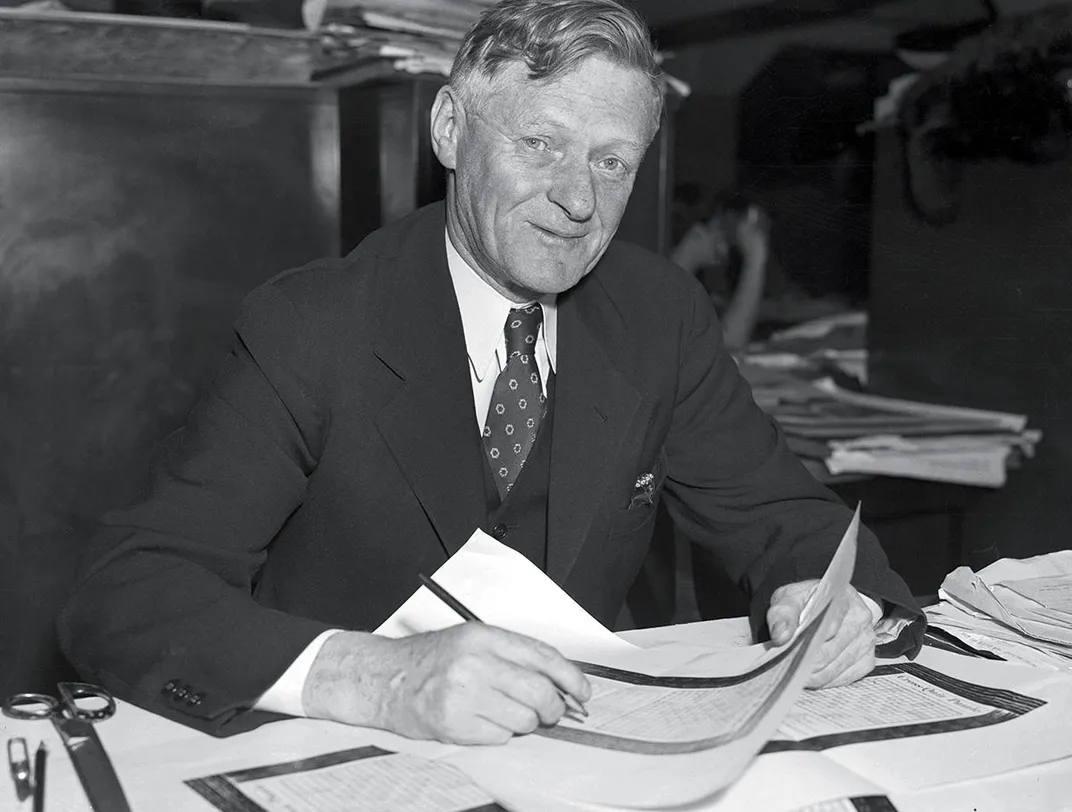How the Crossword Became an American Pastime
The newspaper standby still rivets our attention a century later
/https://tf-cmsv2-smithsonianmag-media.s3.amazonaws.com/filer/17/29/1729bfa3-a553-4a0d-bb8f-23c5542da524/crosswords_final2.jpg)
On a blustery winter day in 1913, Arthur Wynne sat in his office at the New York World and wrestled with a problem. The Christmas edition of “Fun,” the jokes and puzzles supplement he managed, was being laid out and Wynne felt readers needed a new challenge.
A Liverpool native, Wynne had emigrated to the United States at age 19, but before he did he might have seen some rudimentary word-form puzzles, which were popular in late 19th-century England. Perhaps inspired by those, as well as the “Sator” square, an ancient, five-word Latin palindrome, Wynne designed a numbered, diamond-shape grid with an empty center. He inserted “fun” at the top as the first “across” entry and called it “Word-Cross.” Some of the clues required readers to know esoteric facts (apparently “nard” is an aromatic plant that grows mainly in the Himalayas), but others were puckish. An illustrator later accidentally changed “Word-Cross” to “Cross-Word,” with no objection from Wynne, and the name stuck.

Thus Arthur Wynne is credited as the inventor of what is arguably the first mobile game—the American-style crossword puzzle, notable for its intellectual challenge and definitional yet amusing clues.
In 1924, Richard Simon and M. Lincoln Schuster, who had recently opened a publishing house in New York, honored the pleas of Simon’s puzzle-loving aunt and printed a collection of crosswords, throwing in a free pencil to sweeten the deal. The first crossword puzzle book—an untested and decidedly nonliterary format—worried the firm so much that the firm’s name did not appear on the book, which had a small printing of 3,600 copies.
The publisher needn’t have been concerned; the book was an immediate success. The first run sold out quickly and the company ran additional printings. The book eventually sold more than 100,000 copies, perhaps spurred on by groups like the Amateur Cross Word Puzzle League of America, itself a creation of marketing-savvy Simon & Schuster.
The league began the process of standardizing the appearance of crosswords as early as 1924, instituting rules such as “all over interlock,” which meant that no part of the grid could be completely cut off by the black squares; only one-sixth of the squares could be black; and the grid design had to be symmetrical. Other changes, like outlawing two-letter words, came later.
America had now tasted the satisfaction of creating order out of chaos, the Zen of making something from nothing. Solving crosswords could fairly be called a craze. The activity had become so prevalent that the Times of London decried it in an editorial called “An Enslaved America.” Devotees spiced their conversation with obsolete words that were cropping up in crossword puzzles. There was even a 1924 song called “Cross-word Mamma You Puzzle Me (But Papa’s Gonna Figure You Out).”
/https://tf-cmsv2-smithsonianmag-media.s3.amazonaws.com/filer/7c/5f/7c5f2be4-df48-40eb-a108-8b40cf5c96d6/dec2019_d09_prologue.jpg)
The crossword fad, however, plagued librarians, who complained that puzzle “fans” were swarming the reference desk, clamoring for dictionaries and encyclopedias to help find answers, and pushing aside more “legitimate” readers and students.
Crosswords were now being published almost everywhere—except in the New York Times, the last major metropolitan newspaper to offer the puzzle. A 1924 editorial in the Times called crosswords “a primitive sort of mental exercise.”
But the war that began for America in 1941 gave crossword puzzles an important new function: escaping the woes of the news pages. Two weeks after the U.S. joined the hostilities, the New York Times’ Sunday editor sent a memo to the publisher saying they “ought to proceed with the puzzle” to give readers something to do during those bleak blackout hours. To bolster his suggestion, the editor attached a letter from the crossword pioneer Margaret Petherbridge Farrar. “I don’t think I have to sell you on the increased demand for this type of pastime in an increasingly worried world,” she wrote. “You can’t think of your troubles while solving a crossword.”
The first New York Times crossword ran on Sunday, February 15, 1942, with Farrar as editor, and became a daily feature on September 11, 1950. Today the Times’ puzzle—whose clues famously get trickier and more clever Monday to Saturday, with the hefty Sunday puzzle moderate in difficulty—is the one that most puzzle lovers aspire to conquer. Will Shortz, the Times’ crossword editor for more than 25 years, says the fact that the puzzle appears in the Times, the country’s newspaper of record, is significant.
The crossword world exploded in 2006 when the documentary Wordplay was released. A love letter to the die-hard puzzle solvers who religiously attend Shortz’s American Crossword Puzzle Tournament—with appearances by celebrities like Bill Clinton and Jon Stewart, who like to solve the Times’ crossword—it injected a bit of kooky glamour into the grids. Soon solving crosswords was a cool thing for young people to do, much as they are embracing other old pastimes like knitting.
But what kept people solving after they had their first taste of “cruciverbalism”? I like to think it was the humor and wordplay in crossword clues. My favorite clue? “It brings out the child in you.” Answer: “Labor.”
Nothing has had a bigger impact on the way we solve crosswords—or make them—than the internet. As online gaming became popular, puzzle makers realized solvers could get their daily fix on their computers and, eventually, their hand-held devices. The advent of online solving has encouraged independent puzzle makers like the American Values Club Crossword (AVCX) and the Inkubator.
Whether solvers prefer putting pencil (or pen!) to paper or using their smartphones, all crossword publishers agree on one thing: The puzzles should “always be about good vibes,” said Ben Tausig, the 39-year-old editor of the Queens, New York-based AVCX. “The content should be fun—a good laugh with no punching down.”
Download a printable crossword based on the December 2019 issue of Smithsonian here.
Deb Amlen will speak at a Smithsonian Associates event on March 5, 2020.